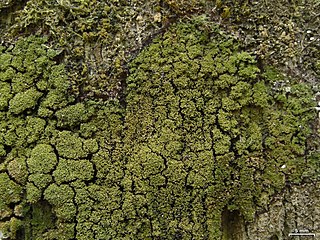
Lichenology is the branch of mycology that studies the lichens, symbiotic organisms made up of an intimate symbiotic association of a microscopic alga with a filamentous fungus. Lichens are chiefly characterized by this symbiosis.

Erik Acharius was a Swedish botanist who pioneered the taxonomy of lichens and is known as the "father of lichenology". Acharius was famously the last pupil of Carl Linnaeus.

Chaenotheca is a genus of lichenized fungi within the family Coniocybaceae. The sexual reproduction structures are a mass of loose ascospores that are enclosed by a cup shaped exciple sitting on top of a tiny stalk, having the appearance of a dressmaker's pin, hence the common name pin lichen. Genus members are also commonly called needle lichens. Photobiont partners for Chaenotheca include members of the algae genera Symbiochloris, Trebouxia, Trentepohlia, and Tritostichococcus.

Pseudevernia furfuracea, commonly known as tree moss, is a lichenized species of fungus that grows on the bark of firs and pines. The lichen is rather sensitive to air pollution, its presence usually indicating good air conditions in the growing place. The species has numerous human uses, including use in perfume, embalming and in medicine. Large amounts of tree moss is annually processed in France for the perfume industry.

Steven B. Selva is Professor Emeritus of Biology and Environmental Studies at the University of Maine at Fort Kent, a lichenologist, and curator of UMFK's lichen herbarium. Selva is an expert on stubble lichens, called so because their millimeter-high stalks resemble beard stubble.

Phyllopsora is a genus of lichen-forming fungi in the family Ramalinaceae. It was circumscribed by Swiss botanist Johannes Müller Argoviensis in 1894, with Phyllopsora breviuscula assigned as the type species.
Aino Marjatta Henssen, was a German lichenologist and systematist. Her father, Gottfried Henssen, was a folklorist and her mother was Finnish.

Miriquidica deusta is a species of lichen in the family Lecanoraceae. A North American native, it generally grows on siliceous rocks. It belongs to the subdivision Pezizomycotina of the division Ascomycota, within the order Lecanorales. These are found in both general and Estonian herbariums.
André Aptroot is a Dutch mycologist and lichenologist. His primary research focus is on biodiversity, particularly tropical lichens, encompassing systematics, floristic surveys, and taxonomic reviews. A prolific researcher, he has published more than 500 scientific papers and described hundreds of new fungal and lichen species.
Dharani Dhar Awasthi was an Indian botanist, taxonomist, and lichenologist, often given the appellation "Father of Indian Lichenology".
Helge Thorsten Lumbsch is a German-born lichenologist living in the United States. His research interests include the phylogeny, taxonomy, and phylogeography of lichen-forming fungi; lichen diversity; lichen chemistry and chemotaxonomy. He is the Associate Curator and Head of Cryptogams and Chair of the Department of Botany at the Field Museum of Natural History.
Per Magnus Jørgensen is a Norwegian botanist and lichenologist, and Professor Emeritus of systematic botany at the University of Bergen. He is known for his work on the lichen families Pannariaceae and Collemataceae. Jørgensen was awarded the Acharius Medal in 2021 for his lifetime contributions to lichenology.

Gunnar Bror Fritiof Degelius was a Swedish lichenologist. Between the publications of his first and final scientific papers, Degelius had a 70-year-long research career. While he was best known for his expertise on the lichen genus Collema, he also wrote important papers on lichen biology and ecology, floristic studies of the Nordic countries and various other areas around the world, and lichen succession. Degelius described 124 new taxa, and published about 130 scientific papers. In 1992 he was one of the first to be awarded the Acharius Medal for his lifetime contributions to lichenology. Fifteen species and three genera have been named in honour of Degelius.
Punctelia pseudocoralloidea is a species of foliose lichen in the family Parmeliaceae. It is found in Australia, where it grows on bark and on wood.
Henricus (Harrie) Johannes Maria Sipman is a retired Dutch lichenologist who specialised in tropical and subtropical lichens and authored or co-authored over 250 scientific publications. He was the curator of the lichen herbarium at the Berlin Botanical Garden and Botanical Museum from 1983 until his retirement in 2010.
The Lichenologist is a peer-reviewed scientific journal specializing in lichenology. It is published bimonthly by the British Lichen Society. According to the Journal Citation Reports, the 2020 impact factor of The Lichenologist is 1.514, ranking it 149 out of 235 in plant sciences and 26 of 29 in mycology.

Jindřich Suza was a Czech professor of botany. He specialised in lichenology and phytogeography.
James Donald Lawrey is a biologist, specialising in lichens. He is known for leading long-term monitoring projects, taxonomy and studies of the evolution of the fungi in lichens.
Chaenotheca papuensis is a species of crustose lichen in the family Coniocybaceae. Found in Papua New Guinea, it was formally described as a new species in 2003 by the lichenologists André Aptroot and Leif Tibell. The type specimen was collected by Aptroot in 1995 from the Owen Stanley Range, at an elevation of about 2,100 m (6,900 ft); there, in the remote mountain village Myola, it was found growing on the bark of huts and on wood.









